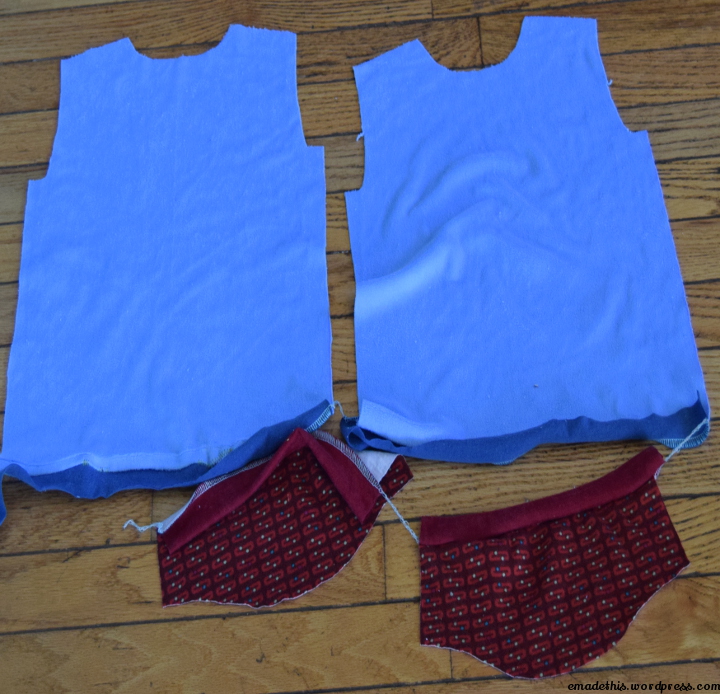I really like assembly line sewing. I feel like it’s a huge challenge to myself to cut out the fluff in my sewing. It’s nice to linger over a project, but sometimes you just need to get things done. If you can figure out where your wasted motion is, you can discover solutions to make yourself more efficient. Batch sewing is an opportunity to fine tune your sewing muscle memory and make yourself more accurate. Plus, you can get through a gigantic stack of much needed t-shirts for your kids and get back to sewing pretty things for yourself. Who doesn’t want to do that?
Today, I’m batch sewing t-shirts for my two younger boys who have outgrown their t-shirts and are in need of a few more short sleeve shirts. My rocket fuel of choice is Melly Sews’ free t-shirt pattern (size 2-4T). I gave my almost 4 yr old a little more width in his side seams, but other than that I cut everything out according to the pattern and got my station ready to go (I do need to shorten the length on my 2 yr old–my bad, not the pattern’s).
When you’re batch sewing, you need to cut everything first. For me, this is easier to do on separate days so I can mentally prepare myself for the batch sewing process, but also because I often cut during spare moments in my day so that I don’t have to waste my precious block of sewing time cutting. After that, serge around edges if necessary before you make your construction stacks (i.e. if you’re batch sewing pants).
Beyond that, here are 8.5 ideas that will help speed up your sewing process when you’re ready to sit down at the machine and sew.
1. Mentally pump yourself up: You’re fixing on performing a 100 yard dash in your sewing room. You don’t have time to look at the directions. Be familiar with the directions and maybe consider reordering them so that you can do as much as you can without moving.
2. Organize your supplies: Batch sewing is not unlike making a stir-fry. Cooks spend all of their active time chopping vegetables, and setting out cups of ingredients for just a few fiery seconds over a hot wok. If anything is not next to the stove, you’re burning what is in the pan. While the consequences of not being fully prepared are not as high when you’re alone in your sewing room, you can prepare your work station similarly for maximum efficiency. Set out any notions that you need in the area that you will need them in. You will not want to be digging through your thread box for the right color when you’re zipping away. Put it on your machine. Shoot, sew everything with the same color so you don’t have to switch anything midstream.
3. Press as much as you can first: Pressing hems in the flat is always easier, especially when dealing with teeny sleeve pieces in kids’ clothing. Also, if your hems are already pressed, you won’t have to stop working when you’ve seamed everything. Press any bindings that you might need and fuse interfacing.
4. Do more time consuming steps first: Yes, you’re making a huge stack of t-shirts, but maybe you want to add an applique, pocket, or an iron-on transfer. Do these things first before you move on to the actual production sewing so that you don’t slow down your flow. If your batch sewing needs buttonholes and you can get away with it, do them first (!) when your brain is fresh. Then you won’t run the risk of potentially ruining it all in the home stretch by doing a terrible job with your buttonholes.
5. Stack in construction order: Set out one garment at a time, stacking it in construction order. Stack wrong sides together, pin sleeves and neck binding to the front with one pin for each piece. If you’re batch sewing pants, put backs to backs and fronts to fronts to start out and put waistband pieces right sides together.
6. Consider not using pins: I’m anti-pins. They slow you down and stab you at inconvenient intervals (You have no time to clean up blood, even if it’s just a flesh wound!). But absolutely, when you’re batch sewing, you don’t have time to stop and take out each pin. You need to keep sewing no matter what. Hold onto your fabric with left hand in back and your right hand pinching your layers together in front, keeping the raw edges even. Let your hands guide the fabric through the machine at the same rate so that you don’t distort anything. As your left hand gets to the back of the machine and your right hand approaches the presser foot, reset your hands at the starting position and keep going.
7. Better matched seams: I’m a bit obsessive about seam matching. 98% of the time, I will run a few basting stitches along the seamline where seams come together so that I can be assured that the seam will indeed match and so that I don’t have to pin later. When I’m trying to do a bunch of production sewing like making a stack of t-shirts or pants, I don’t want to take the extra time to do this. What I’ve discovered is that if you go over a seam matching point with the seam facing away from the presser foot, your chances of being accurate without pins or basting goes up. If the seam faces the presser foot, the presser foot can stretch the seam crossing on top away from the seam crossing that’s next to the feed dogs. Sew along, and as you get to the seam crossing, match it up with your hands and slow your speed to go over the bulk. You’ll be amazed at how accurately you can match the point of intersection!
8. Sew flat, and keep sewing: Setting a sleeve in the round is 10X more difficult and takes 10X longer than when you sew the sleeve in flat and then sew the underarm seam and side seam in one go. Everything that you can sew in flat, do so.
Also, sew as much as possible before you press anything. Don’t stop to cut threads between pieces. Cut everything apart at the ironing board in one go, and press everything in as large a batch as possible before you move on. You might sew things all out of “proper” order, but you’ll get through everything faster.
And lastly.:

8.5. Don’t Screw Up: Your seam ripper doesn’t judge, but every time you need to use it, obviously you’ll slow everything down. So try not to need it (ha!).
In no time, you will have assembly-lined your way to sewing hero status.
**Today I clocked in at 1’45” for these 6 t-shirts. I had a couple of hiccups in not nipping my bindings and several sleeves beforehand and I totally used pins for the sleeves against my own advice…next time it’ll go faster…**









Some great tips there, and three gorgeous boys.
Thanks! And I think so too. 😉
Those are some great tips. Wow-I am so impressed that you could make six t-shirts that fast! And they look great. I liked your idea to cut during spare time during the day because I have one precious block of time to sew too and I do hate it when I end up using the whole block just for cutting!
I totally agree! Those days you end up only cutting always feel like you didn’t accomplish anything (even though you did, especially if you’re cutting a gigantic project like a jacket). |
#4 & #7: so smart! Yes, one makes more mistakes when tired and/or at the end of a sewing session–it’s really a brilliant idea. Start with the worst first. And thanks for the great tip on matching seams when marathon sewing, because mine have always turned out wonky–genius idea. Cheers Elizabeth! BTW wow, look what you’ve done with your website! Amazing 🙂
Thanks! The seam matching is my favorite trick. It really works. More prettifying changes are coming to the blog too, so stay tuned!